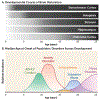Translating Developmental Neuroscience to Understand Risk for Psychiatric Disorders
- PMID: 30818985
- PMCID: PMC11019454
- DOI: 10.1176/appi.ajp.2019.19010091
Translating Developmental Neuroscience to Understand Risk for Psychiatric Disorders
Abstract
The transition from childhood to adulthood represents the developmental time frame in which the majority of psychiatric disorders emerge. Recent efforts to identify risk factors mediating the susceptibility to psychopathology have led to a heightened focus on both typical and atypical trajectories of neural circuit maturation. Mounting evidence has highlighted the immense neural plasticity apparent in the developing brain. Although in many cases adaptive, the capacity for neural circuit alteration also induces a state of vulnerability to environmental perturbations, such that early-life experiences have long-lasting implications for cognitive and emotional functioning in adulthood. The authors outline preclinical and neuroimaging studies of normative human brain circuit development, as well as parallel efforts covered in this issue of the Journal, to identify brain circuit alterations in psychiatric disorders that frequently emerge in developing populations. Continued translational research into the interactive effects of neurobiological development and external factors will be crucial for identifying early-life risk factors that may contribute to the emergence of psychiatric illness and provide the key to optimizing treatments.
Keywords: Adolescents; Anxiety Disorder-Generalized; Biological Markers; Neurodevelopment; Neuroimaging; Schizophrenia.
Conflict of interest statement
The authors report no financial relationships with commercial interests.
Figures
Similar articles
-
Translating Developmental Neuroscience to Understand Risk for Psychiatric Disorders.Am J Psychiatry. 2023 Aug 1;180(8):540-547. doi: 10.1176/appi.ajp.19010091. Am J Psychiatry. 2023. PMID: 37525605 Review.
-
Right care, first time: a highly personalised and measurement-based care model to manage youth mental health.Med J Aust. 2019 Nov;211 Suppl 9:S3-S46. doi: 10.5694/mja2.50383. Med J Aust. 2019. PMID: 31679171
-
New Insights Highlighting Neurodevelopmental Issues That Predispose to Childhood and Adolescent Psychopathology.Am J Psychiatry. 2019 Mar 1;176(3):171-172. doi: 10.1176/appi.ajp.2019.19010092. Am J Psychiatry. 2019. PMID: 30818983 No abstract available.
-
The impact of the environment on neurodevelopmental disorders in early childhood.J Pediatr (Rio J). 2022 Mar-Apr;98 Suppl 1(Suppl 1):S66-S72. doi: 10.1016/j.jped.2021.11.002. Epub 2021 Dec 13. J Pediatr (Rio J). 2022. PMID: 34914896 Free PMC article. Review.
-
[The role of psychosocial stress in childhood for structural and functional brain development:neurobiological basis of developmental psychopathology].Prax Kinderpsychol Kinderpsychiatr. 1997 Nov;46(9):623-44. Prax Kinderpsychol Kinderpsychiatr. 1997. PMID: 9478077 Review. German.
Cited by
-
Developmental Manipulation-Induced Changes in Cognitive Functioning.Curr Top Behav Neurosci. 2023;63:241-289. doi: 10.1007/7854_2022_389. Curr Top Behav Neurosci. 2023. PMID: 36029460 Free PMC article.
-
Brain-immune interaction mechanisms: Implications for cognitive dysfunction in psychiatric disorders.Cell Prolif. 2022 Oct;55(10):e13295. doi: 10.1111/cpr.13295. Epub 2022 Jul 20. Cell Prolif. 2022. PMID: 35860850 Free PMC article. Review.
-
Developmental Shifts in Amygdala Activity during a High Social Drive State.J Neurosci. 2021 Nov 10;41(45):9308-9325. doi: 10.1523/JNEUROSCI.1414-21.2021. Epub 2021 Oct 5. J Neurosci. 2021. PMID: 34611026 Free PMC article.
-
Using animal models for the studies of schizophrenia and depression: The value of translational models for treatment and prevention.Front Behav Neurosci. 2022 Aug 24;16:935320. doi: 10.3389/fnbeh.2022.935320. eCollection 2022. Front Behav Neurosci. 2022. PMID: 36090659 Free PMC article. Review.
-
Adolescents exhibit reduced Pavlovian biases on instrumental learning.Sci Rep. 2020 Sep 25;10(1):15770. doi: 10.1038/s41598-020-72628-w. Sci Rep. 2020. PMID: 32978451 Free PMC article.
References
-
- Kessler RC, Berglund P, Demler O, et al. Lifetime prevalence and age-of-onset distributions of DSM-IV disorders in the National Comorbidity Survey Replication. Arch Gen Psychiatry 2005; 62:593–602 - PubMed
-
- Kessler RC, Wang PS: The descriptive epidemiology of commonly occurring mental disorders in the United States. Annu Rev Public Health 2008; 29:115–129 - PubMed
-
- Welsh JW, Knight JR, Hou SS-Y, et al. Association between substance use diagnoses and psychiatric disorders in an adolescent and young adult clinic-based population. J Adolesc Health 2017; 60:648–652 - PubMed
-
- Andersen SL, Teicher MH: Stress, sensitive periods, and maturational events in adolescent depression. Trends Neurosci 2008; 31:183–191 - PubMed
Publication types
MeSH terms
Grants and funding
LinkOut - more resources
Full Text Sources
Medical


